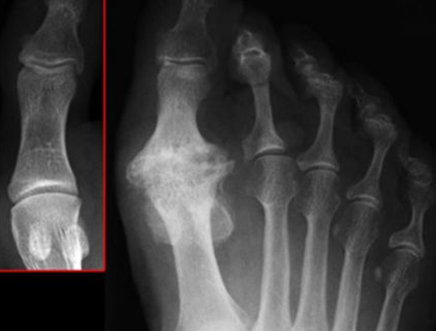Hallux Rigidus (Osteoarthritis of the big toe joint)
This disorder is a progressive osteoarthritic change, taking place at the 1st metatarsophalangeal joint. It has been associated with many possible causes. It can be post-traumatic (ie-secondary to injury) but it often isn’t. The rheumatoid arthritic and diabetic patient are more prone to developing this condition but it has a broad based prevalence. As with hallux valgus patients with hallux rigidus often experience a reduction in quality of life, mobility and experience foot wear fitting difficulties.
Hallux rigidus can be managed quite well in the early stages with foot orthoses and appropriate footwear. However, once the range of motion reduces significantly then conservative management (ie-non-surgical) proves far less effective. The extent of damage can be assessed by plain film radiograph evaluation (x-rays), range of motion studies and the use of quality of life measurement tools such as the Foot Health Status Questionnaire. As with hallux valgus surgery a large variety of techniques exist to address the pain and disability associated with this complaint. Such technique may preserve the joint, reconstruct the joint or be joint destructive. Each of these options can be discussed with the appropriate procedure selected based on the extent of the joint disease process and preference of the patient.
A technique called a capsular interpositional arthroplasty procedure is commonly used by podiatric surgeons preserving as much range of motion as possible whilst eliminating pain. An arthrodesis procedure (ie- joint fusion with or without a graft - video three) is reported by the literature as achieving excellent reduction in pain but it completely eliminated range of motion of the joint. This may not be a preference for some patients and should be discussed with our practitioners.

This plain film radiograph (x-ray) demonstrates a normal joint in comparison with a severe case of hallux rigidus.
An arthrodesis procedure with/without a bone graft can be an effective means of treating hallux rigidis. Please click below (video two) to see a simple example of this procedure.
Suite 8 (Ground Floor), 146 Scollay St, Greenway ACT 2900
6287 4889
6293 2325
[email protected]
ACT Podiatry : Advanced Foot & Ankle Centre
Canberra Podiatric Surgeon
Suites 16-17 (First floor) 14-16 Brierly St, Weston ACT 2611
6287 2818
6293 2325
[email protected]
ACT Podiatry : Advanced Foot & Ankle Centre
Canberra Podiatric Surgeon
Copyright © 2018, ACT PODIATRY | SEO by High Jump Digital

